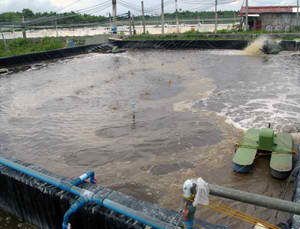Farmed shrimps is an important foreign exchange earner. The Philippines is the 6th largest producer of shrimps with annual production of about 50,000 metric tons (mt).
However, outbreak of diseases such as White Spot Syndrome Virus (WSSV), Hypodermic Haematopoetic Infectious Necrosis Virus (IHHNV), Taura Syndrome Virus (TSV), and Yellow Head Virus (YHV) has slumped the industry.
Biofloc in concrete tanks

To respond to this concern, the Philippine Council for Agriculture, Aquatic and Natural Resources Research and Development of the Department of Science and Technology (DOST-PCAARRD) has developed the Industry Strategic S&T Program (ISP) on Shrimp.
The ISP aims to revitalize the shrimp industry by reducing the occurrence of diseases in shrimps and improving yields through sound management practices.
One of the initiatives under the Shrimp ISP is the biofloc technology (BFT), which is implemented by the University of the Philippines Visayas (UPV) under the leadership of Dr. Valeriano L. Corre, Jr.
BFT uses a microbial mat composed of aggregates of bacteria, algae, protozoa, detritus, and dead organic particles that help control the natural microbial activity in aquaculture ponds.
The use of this technology helps reduce reliance on protein from feeds and it stabilizes water quality through waste recycling.
BFT improves shrimp’s nutrition, as it enhances feed conversion ratio (FCR), resulting in larger shrimps.
Moreover, when carbon and nitrogen are sufficient in the culture system, the biofloc increases in number and size, thus more visible to shrimps for their consumption.

Production of shrimp can be aided by the biofloc technology (Photo from the Inland Aquatic Resources Research Division, PCAARRD)
Disease control can also be achieved through this technology. A well-developed biofloc water can contain more than 2,000 bacterial species, which can enhance shrimp’s immune system.
In terms of investment, BFT may require a high capital, but it can be offset by higher production per cycle.
BFT has already been pilot tested in three farms in Luzon, two in Visayas, and two in Mindanao.
An average of 5.5 kg/cubic meter (m3) of P. vannamei in tanks were realized, while an average of 18 tons/ha for P. vannamei was produced in the trials in the ponds.
A feed conversion ratio (FCR) of 1.3 was attained with 95% survival rate, with a stocking density of 800,000 per hectare in a 90-day culture period.
DOST-PCAARRD will showcase biofloc technology including other agri-aqua research and development (R&D) outputs on March 2-4, 2016 during the SIPAG FIESTA at its headquarters in Los Baños, Laguna.
SIPAG, a technology transfer strategy, embodies the Council’s commitment to DOST’s Outcome One in a bid to ensure that the fruits of R&D activities for the agri-aqua sectors will be a blessing for every Juan.
by Adelaida T. Calpe, DOST-PCAARRD S&T Media Service

